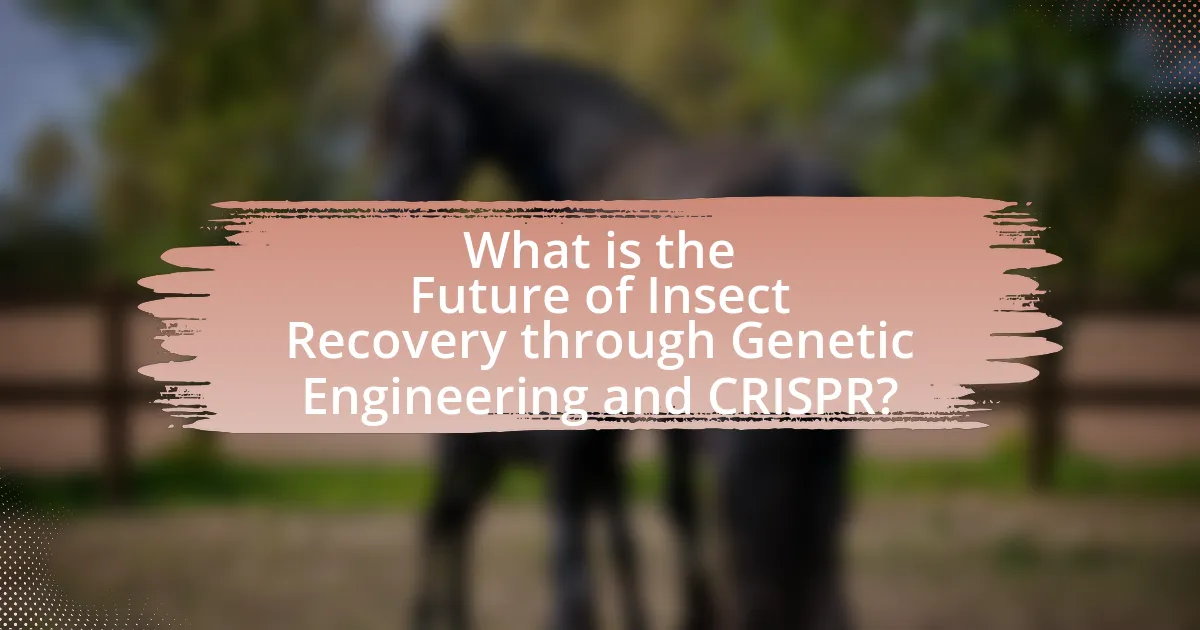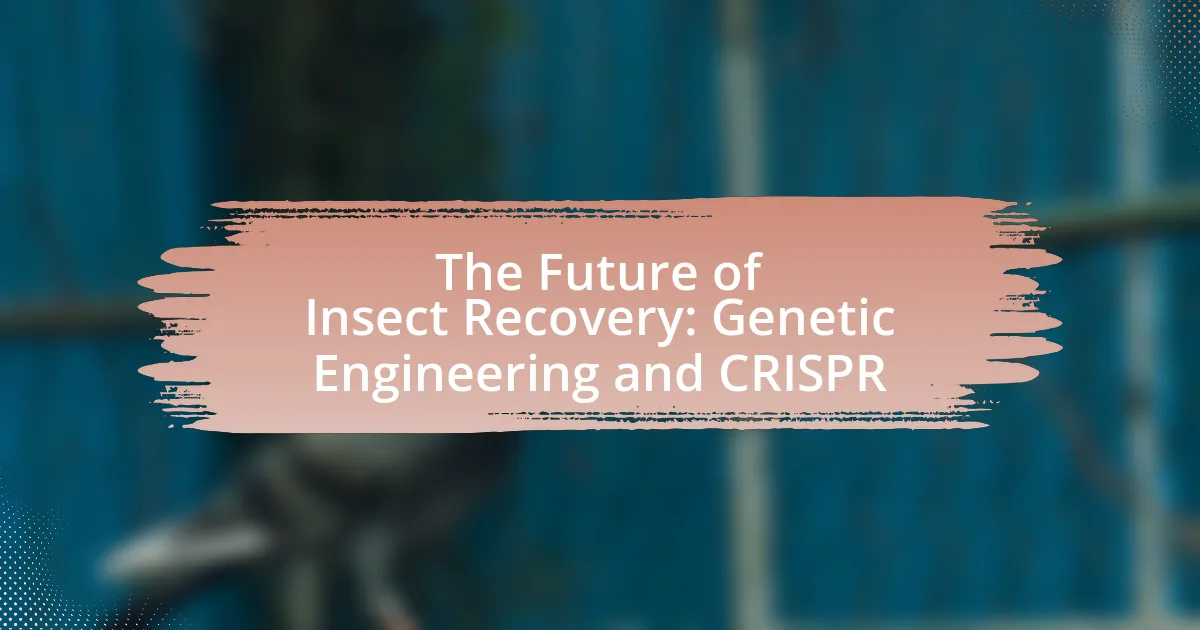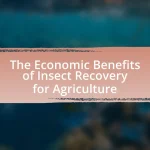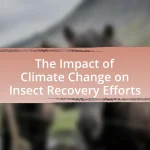The article focuses on the future of insect recovery through genetic engineering and CRISPR technology, highlighting their potential to enhance biodiversity and restore ecosystems. It discusses how genetic engineering can modify insect genomes to improve resilience against diseases and environmental changes, while CRISPR enables precise gene editing to revive endangered species and control invasive populations. Key techniques such as CRISPR-Cas9, transgenesis, and gene drive systems are examined, along with the ecological roles of insects and the importance of their recovery for maintaining ecosystem stability. The article also addresses ethical considerations, potential risks, and the need for collaboration among stakeholders to ensure successful implementation of these technologies in conservation efforts.

What is the Future of Insect Recovery through Genetic Engineering and CRISPR?
The future of insect recovery through genetic engineering and CRISPR technology is promising, as these methods can enhance biodiversity and restore ecosystems. Genetic engineering allows for the modification of insect genomes to increase resilience against diseases and environmental changes, while CRISPR enables precise editing of genes to potentially revive endangered species or control invasive populations. For instance, research has demonstrated that CRISPR can be used to create gene drives that spread beneficial traits through insect populations, which could help combat pests that threaten crops and human health. This approach has been validated in studies such as those conducted by the Broad Institute, which showed successful gene editing in various insect species.
How does genetic engineering contribute to insect recovery?
Genetic engineering contributes to insect recovery by enabling the modification of insect populations to enhance their resilience and adaptability to environmental changes. Techniques such as CRISPR allow scientists to edit genes associated with traits like disease resistance, reproductive success, and habitat adaptability. For instance, research has demonstrated that genetically engineered mosquitoes can be designed to resist malaria, thereby reducing disease transmission and supporting healthier ecosystems. This targeted approach not only aids in the recovery of specific insect species but also helps maintain biodiversity, as healthier insect populations can better fulfill their ecological roles.
What are the key techniques used in genetic engineering for insects?
The key techniques used in genetic engineering for insects include CRISPR-Cas9, transgenesis, and gene drive systems. CRISPR-Cas9 allows for precise editing of the insect genome by creating targeted double-strand breaks, which can be repaired with desired genetic material. Transgenesis involves introducing foreign DNA into an insect’s genome, enabling the expression of new traits, such as pest resistance or altered reproductive capabilities. Gene drive systems promote the inheritance of specific genes at higher rates than normal, effectively spreading desired traits through populations. These techniques have been validated through various studies, demonstrating their effectiveness in modifying insect traits for agricultural and ecological purposes.
How does genetic engineering address the challenges faced by insect populations?
Genetic engineering addresses the challenges faced by insect populations by enabling the modification of their genetic traits to enhance survival and adaptability. For instance, techniques like CRISPR can be used to create genetically modified insects that are resistant to diseases, pests, or environmental changes, thereby improving their chances of survival. Research has demonstrated that genetically engineered mosquitoes, designed to reduce the transmission of diseases like malaria, have shown significant reductions in disease-carrying populations, illustrating the potential of genetic engineering to mitigate threats to insect populations and promote ecological balance.
What role does CRISPR play in insect recovery?
CRISPR plays a crucial role in insect recovery by enabling precise genetic modifications that can enhance resilience to environmental changes and diseases. This technology allows scientists to edit genes associated with traits such as pest resistance, reproductive success, and adaptability, thereby improving insect populations that are declining due to habitat loss, climate change, and other stressors. For instance, research has demonstrated that CRISPR can be used to create genetically modified mosquitoes that are resistant to malaria, potentially reducing disease transmission and supporting population recovery.
How does CRISPR technology work in modifying insect genomes?
CRISPR technology modifies insect genomes by utilizing a guide RNA to direct the Cas9 enzyme to specific DNA sequences, where it creates double-strand breaks. This mechanism allows for precise editing of the genome, enabling the insertion, deletion, or alteration of genetic material. For instance, researchers have successfully used CRISPR to modify the genomes of mosquitoes to reduce their ability to transmit diseases like malaria, demonstrating its potential in controlling insect populations and enhancing pest resistance. The effectiveness of CRISPR in insects is supported by studies showing significant alterations in traits such as fertility and disease resistance, confirming its role as a powerful tool in genetic engineering.
What are the potential advantages of using CRISPR for insect recovery?
The potential advantages of using CRISPR for insect recovery include enhanced genetic diversity, targeted pest control, and accelerated breeding programs. CRISPR technology allows for precise editing of insect genomes, which can increase genetic variation within populations, making them more resilient to environmental changes and diseases. Additionally, CRISPR can be employed to develop insects that are resistant to pests or diseases, reducing the need for chemical pesticides and promoting healthier ecosystems. Furthermore, CRISPR facilitates faster and more efficient breeding processes, enabling the rapid development of beneficial traits in insect populations, which is crucial for conservation efforts.
Why is insect recovery important for ecosystems?
Insect recovery is crucial for ecosystems because insects play essential roles in pollination, nutrient cycling, and food web dynamics. For instance, approximately 75% of flowering plants depend on insect pollinators, which directly supports global food production and biodiversity. Additionally, insects contribute to the decomposition of organic matter, facilitating nutrient recycling that sustains soil health and plant growth. The decline of insect populations disrupts these processes, leading to reduced ecosystem resilience and functionality. Studies indicate that a significant loss of insect diversity can result in cascading effects throughout food webs, ultimately threatening the stability of entire ecosystems.
What ecological roles do insects play that necessitate their recovery?
Insects play crucial ecological roles that necessitate their recovery, including pollination, decomposition, and serving as a food source for various animals. Pollinators, such as bees and butterflies, are responsible for the fertilization of approximately 75% of flowering plants, which is vital for food production and ecosystem health. Decomposers, like beetles and ants, break down organic matter, recycling nutrients back into the soil, which supports plant growth and soil health. Additionally, insects are a primary food source for many birds, mammals, and amphibians, contributing to the stability of food webs. The decline of insect populations threatens these essential functions, leading to potential ecosystem collapse and loss of biodiversity.
How does the decline of insect populations impact biodiversity?
The decline of insect populations significantly reduces biodiversity by disrupting ecosystems and food webs. Insects play crucial roles as pollinators, decomposers, and as a food source for various animals; their decline leads to decreased plant reproduction, nutrient cycling, and the survival of species that rely on insects for sustenance. For instance, studies indicate that a 75% decline in insect biomass can lead to a corresponding decline in bird populations, as many birds depend on insects for food. This cascading effect threatens the stability of ecosystems, ultimately resulting in a loss of species diversity and ecosystem services.
What ethical considerations arise from using genetic engineering and CRISPR in insect recovery?
The ethical considerations arising from using genetic engineering and CRISPR in insect recovery include potential ecological impacts, unintended consequences, and issues of consent. Genetic engineering may disrupt existing ecosystems by introducing modified insects that could outcompete native species, leading to biodiversity loss. Unintended consequences may arise from gene editing, such as unforeseen mutations that could harm the target species or other organisms within the ecosystem. Additionally, the lack of consent from affected communities and ecosystems raises ethical questions about the rights of nature and the responsibilities of scientists. These considerations highlight the need for careful assessment and regulation in the application of these technologies.
How do we balance technological advancement with ecological integrity?
Balancing technological advancement with ecological integrity involves implementing sustainable practices in genetic engineering and CRISPR applications. Sustainable practices ensure that innovations do not harm ecosystems while enhancing biodiversity. For instance, research indicates that CRISPR can be used to create genetically modified organisms that are more resilient to environmental changes, thereby supporting ecological stability. A study published in “Nature Biotechnology” by Zhang et al. (2020) demonstrates how gene editing can help restore endangered insect populations without disrupting existing ecosystems. This approach highlights the potential for technology to contribute positively to ecological integrity when guided by ethical considerations and scientific evidence.
What are the potential risks associated with genetically modified insects?
The potential risks associated with genetically modified insects include ecological disruption, unintended consequences on non-target species, and the development of resistance in pest populations. Ecological disruption can occur if genetically modified insects outcompete native species, leading to a decline in biodiversity. For instance, the release of genetically modified mosquitoes designed to reduce disease transmission has raised concerns about their impact on local ecosystems and the potential extinction of certain mosquito species. Unintended consequences may arise from gene flow, where modified genes transfer to wild populations, potentially altering their behavior or reproductive success. Additionally, the development of resistance in pest populations can undermine the effectiveness of genetically modified insects, as seen in agricultural contexts where pests evolve resistance to genetically engineered traits. These risks highlight the need for thorough risk assessments and monitoring before the widespread release of genetically modified insects.
How can we effectively implement genetic engineering and CRISPR for insect recovery?
To effectively implement genetic engineering and CRISPR for insect recovery, researchers should focus on targeted gene editing to enhance traits such as disease resistance, reproductive success, and environmental adaptability. For instance, CRISPR can be utilized to modify genes responsible for susceptibility to pathogens, thereby increasing insect populations that are crucial for ecosystem balance. Studies have shown that gene drives, which promote the inheritance of specific genes, can be employed to spread beneficial traits rapidly through populations, as demonstrated in the work by Gantz and Bier (2015) in “Science,” where they successfully used gene drives in fruit flies. This approach not only aids in recovery efforts but also ensures that the modified insects can thrive in their natural habitats, contributing to biodiversity restoration.
What best practices should be followed in the application of these technologies?
Best practices in the application of genetic engineering and CRISPR technologies for insect recovery include ensuring regulatory compliance, conducting thorough risk assessments, and engaging in transparent stakeholder communication. Regulatory compliance is essential to adhere to local and international guidelines, which helps mitigate potential ecological risks. Thorough risk assessments should evaluate the potential impacts on ecosystems and non-target species, as demonstrated by studies indicating that unintended gene flow can affect biodiversity. Transparent communication with stakeholders, including the public and environmental organizations, fosters trust and facilitates informed discussions about the benefits and risks associated with these technologies.
How can stakeholders collaborate to ensure successful insect recovery initiatives?
Stakeholders can collaborate to ensure successful insect recovery initiatives by forming partnerships that integrate scientific research, policy-making, and community engagement. Collaborative efforts can include joint research projects that utilize genetic engineering and CRISPR technology to enhance insect populations, while also developing regulatory frameworks that support these innovations. For instance, the collaboration between universities, government agencies, and non-profit organizations can lead to the establishment of best practices for the application of CRISPR in restoring endangered insect species. Evidence from successful initiatives, such as the use of CRISPR to combat the spread of invasive species, demonstrates that multi-stakeholder engagement can lead to effective solutions for insect recovery.
What are the future prospects for insect recovery using genetic engineering and CRISPR?
The future prospects for insect recovery using genetic engineering and CRISPR are promising, as these technologies can enhance biodiversity and restore populations of endangered species. Genetic engineering allows for the introduction of beneficial traits, such as disease resistance or increased reproductive rates, while CRISPR enables precise editing of genes to eliminate harmful traits or enhance survival capabilities. For instance, research has demonstrated that CRISPR can be used to create gene drives that spread advantageous genes through populations, potentially reversing declines in species like the monarch butterfly. Studies indicate that targeted interventions using these technologies could significantly improve the resilience of insect populations facing threats from climate change and habitat loss.
What advancements in technology could further enhance insect recovery efforts?
Advancements in genetic engineering and CRISPR technology could significantly enhance insect recovery efforts by enabling precise modifications to insect genomes. For instance, CRISPR can be utilized to increase the resilience of insect populations against diseases and environmental changes, thereby improving their survival rates. Research has demonstrated that gene editing can effectively introduce traits such as disease resistance in species like the mosquito, which can help control populations of disease-carrying insects. Additionally, advancements in synthetic biology can facilitate the creation of new habitats or food sources tailored to support specific insect species, further aiding in their recovery. These technologies collectively provide innovative solutions to combat the decline of insect populations, which are crucial for ecosystem health and biodiversity.
How can public awareness and education support insect recovery initiatives?
Public awareness and education can significantly support insect recovery initiatives by fostering a deeper understanding of the ecological roles insects play and the threats they face. Increased public knowledge can lead to greater community involvement in conservation efforts, as evidenced by studies showing that informed citizens are more likely to participate in habitat restoration and advocacy for sustainable practices. For instance, educational programs that highlight the importance of pollinators have been linked to increased local initiatives aimed at protecting these species, demonstrating that awareness directly correlates with action. Furthermore, campaigns that educate the public about the benefits of genetic engineering and CRISPR technology in restoring insect populations can help mitigate fears and misconceptions, thereby facilitating acceptance and support for innovative recovery strategies.


